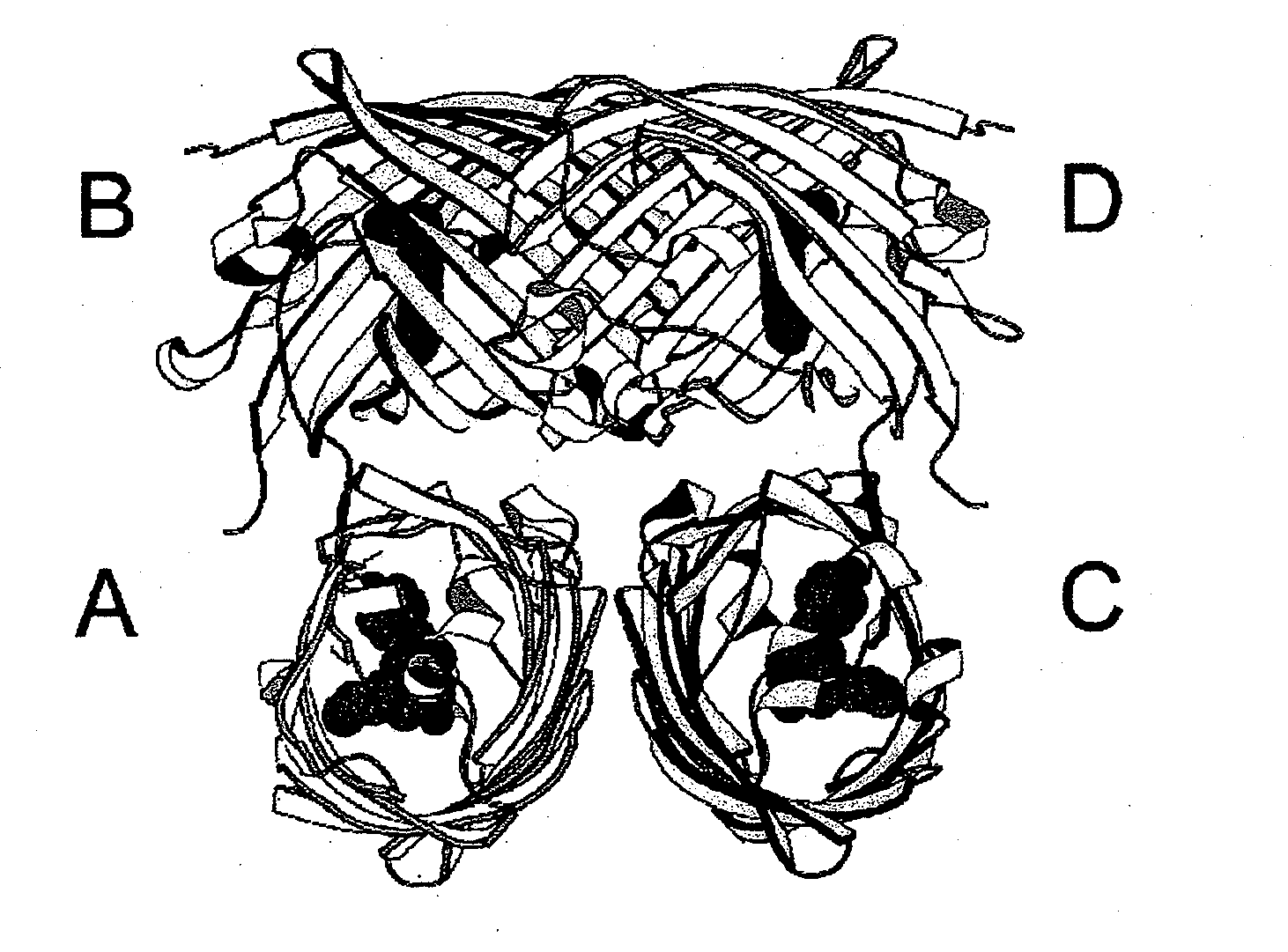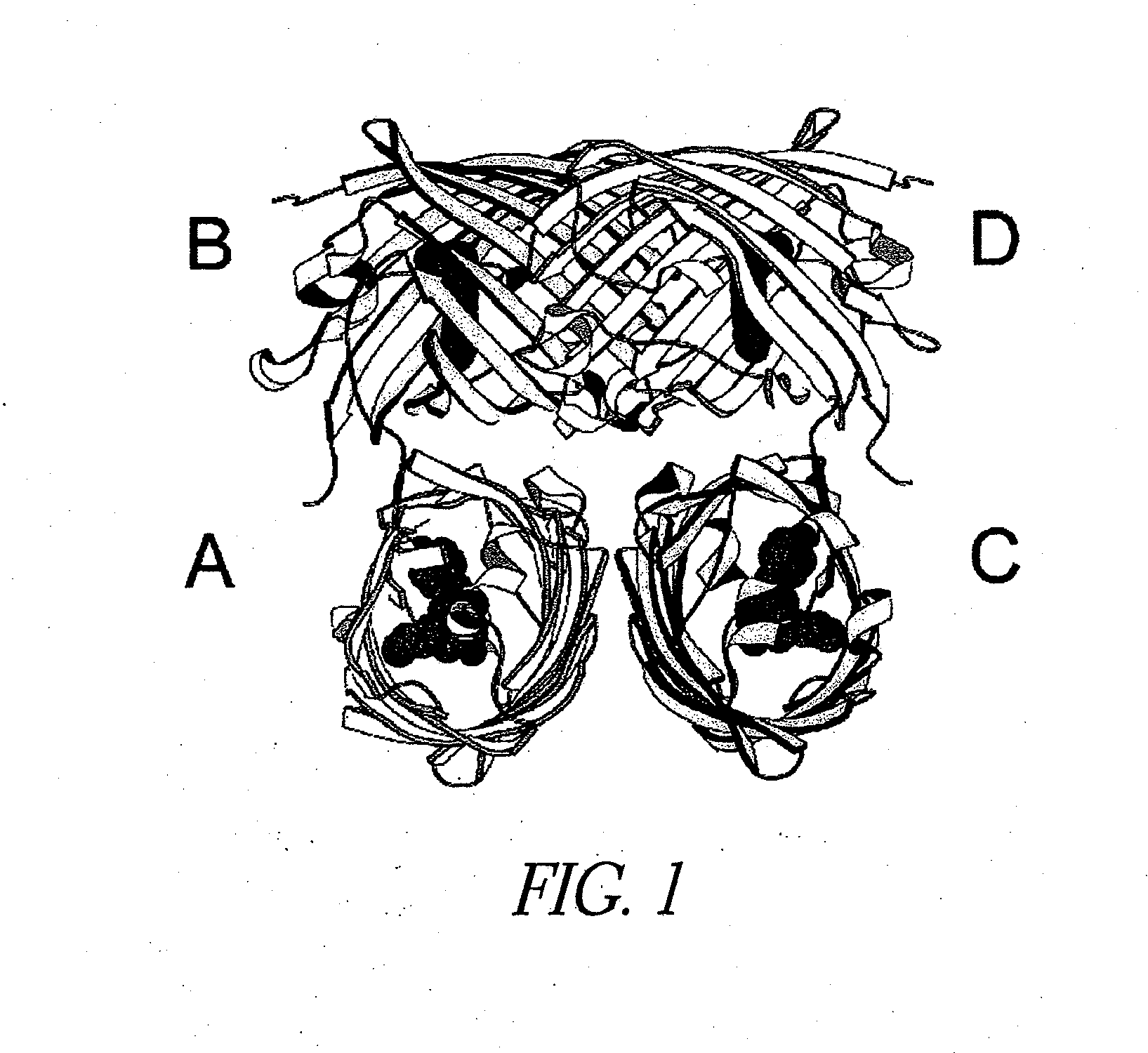Monomeric and dimeric fluorescent protein variants and methods for making same
a fluorescent protein and monomer technology, applied in the field of variant fluorescent proteins, can solve the problems of tetramerization, slow and inefficient chromophore maturation, and hindered scientific curiosity development, and achieve the effect of reducing the propensity to tetramerize and high fluorescence intensity
- Summary
- Abstract
- Description
- Claims
- Application Information
AI Technical Summary
Benefits of technology
Problems solved by technology
Method used
Image
Examples
example 1
Construction of Dimeric and Monomeric Red Fluorescent Proteins DsRed Mutagenesis and Screening
[0229]The DsRed gene was amplified from vector pDsRed-N1 (CLONTECH, Palo Alto, Calif.) or the T1 variant (provided by B. S. Glick, University of Chicago) and subcloned into pRSETB (Invitrogen™; see Baird et al., Proc. Natl. Acad. Sci. USA 97:11984-11989 [2000]). The pRSETB vector produces 6×His tagged fusion proteins, where an N-terminal polyhistidine tag having the following sequence is coupled to the suitably subcloned sequence:
MRGSHHHHHHGMASMTGGQQMGRDLYDDDDKDP(SEQ ID NO: 22)
[0230]This resulting construct was used as the template for introduction of the I125R mutant using the QuikChange™ Site Directed Mutagenesis Kit (Stratagene®), according to the manufacturer's instructions. The complete DsRed wild-type cDNA and polypeptide sequences are provided in GenBank Accession Number AF168419. This nucleotide sequence is also provided in FIG. 16 and SEQ ID NO: 2. A variation of this nucleotide se...
example 2
Preparation and Characterization of Fluorescent Protein Variants
[0301]This example demonstrates that mutations can be introduced into GFP spectral variants that reduce or eliminate the ability of the proteins to oligomerize.
[0302]ECFP (SEQ ID NO: 11) and EYFP-V68L / Q69K (SEQ ID NO: 12) at the dimer interface were subcloned into the bacterial expression vector pRSETB (Invitrogen Corp., La Jolla Calif.), creating an N-terminal His6 tag on the of ECFP (SEQ ID NO: 11) and EYFP-V68L / Q69K (SEQ ID NO: 12), which allowed purification of the bacterially expressed proteins on a nickel-agarose (Qiagen) affinity column. All dimer-related mutations in the cDNAs were created by site-directed mutagenesis using the QuickChange mutagenesis kit (Stratagene), then expressed and purified in the same manner. All cDNAs were sequenced to ensure that only the desired mutations existed.
[0303]EYFP-V68L / Q69K (SEQ ID NO: 12) was mutagenized using the QuickChange kit (Stratagene). The overlapping mutagenic prime...
example 3
Characterization of the Coral Red Fluorescent Protein, DsRed, and Mutants Thereof
[0314]This example describes the initial biochemical and biological characterization of DsRed and DsRed mutants.
[0315]The coding sequence for DsRed was amplified from pDsRed-N1 (Clontech Laboratories) with PCR primers that added an N terminal BamHI recognition site upstream of the initiator Met codon and a C terminal Eco RI site downstream of the STOP codon. After restriction digestion, the PCR product was cloned between the Bam HI and Eco RI sites of pRSETB (Invitrogen), and the resulting vector was amplified in DH5α bacteria. The resulting plasmid was used as a template for error-prone PCR (Heim and Tsien, Curr. Biol. 6:178-182, 1996, which is incorporated herein by reference) using primers that were immediately upstream and downstream of the DsRed coding sequence, theoretically allowing mutation of every coding base, including the initiator Met. The ″ mutagenized PCR fragment was digested with Eco RI...
PUM
 Login to View More
Login to View More Abstract
Description
Claims
Application Information
 Login to View More
Login to View More - R&D
- Intellectual Property
- Life Sciences
- Materials
- Tech Scout
- Unparalleled Data Quality
- Higher Quality Content
- 60% Fewer Hallucinations
Browse by: Latest US Patents, China's latest patents, Technical Efficacy Thesaurus, Application Domain, Technology Topic, Popular Technical Reports.
© 2025 PatSnap. All rights reserved.Legal|Privacy policy|Modern Slavery Act Transparency Statement|Sitemap|About US| Contact US: help@patsnap.com



